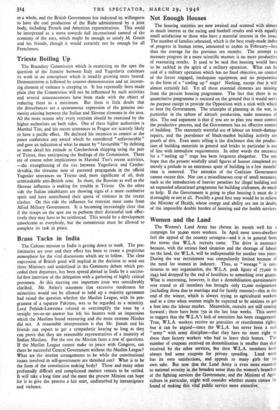Women and the Land
The Women's Land Army has chosen its month well for a campaign for 30,000 more workers. In April most town-dwellers feel the appeal of the country strongest—and it is in general from the towns that W.L.A. recruits come. The drive is necessary because, with the serious food situation and the shortage of labour on the land, the W.L.A. will be indispensable for another two years. During the war recruitment was compulsorily limited because of the need for women in industry. Thus, as " wastage " is con- tinuous in any organisation, the W.L.A. peak figure of 77,000 in 1943 had dropped by the end of hostilities to something over 40,00o. What is interesting, however, is that a demobilisation questionnaire sent round to all members has brought only 12,000 resignations (including those due to marriage and for family reasons)—this at the end of the winter, which is always trying to agricultural workers and at a time when women might be expected to be anxious to get a foot into the labour market. Meanwhile, recruits are still coming forward ; there have been 750 in the last four weeks. This seems to suggest that the W.L.A.'s lack of amenities has been exaggerated. True, W.L.A. workers receive no gratuities or resettlement rights, but it can be argued—since the W.L.A. has never been a real " army " with army discipline—that they have no more right to these than factory workers who had to leave their homes. The number of coupons received on demobilisation is smaller than that received by the other services, but then W.L.A. members have always had some coupons for private spending. Land work has its own satisfactions, and appeals to many girls for its own sake. But now that the Land Army is even more essential to national security in the broadest sense than the women's branches of the fighting services the Government, and the Minister of Agri- culture in particular, might well consider whether means cannot be found of making this vital public service more attractive.


























 Previous page
Previous page